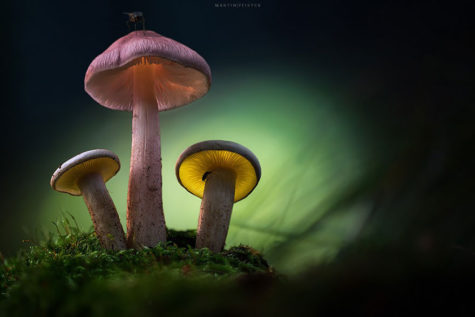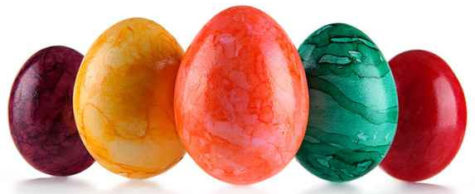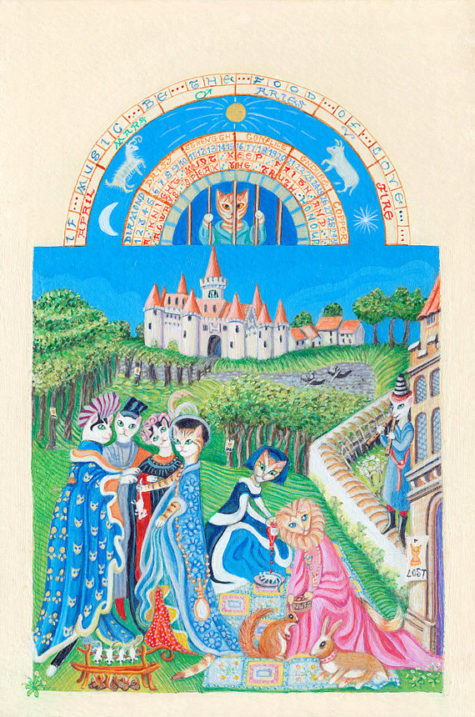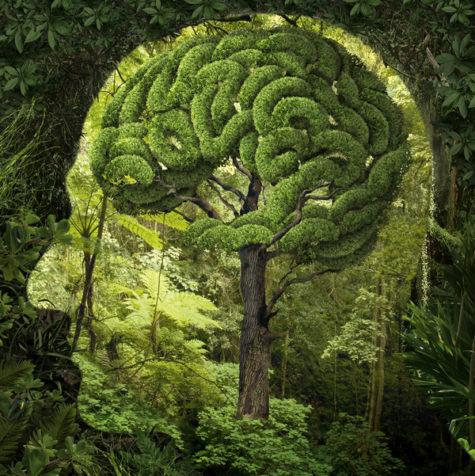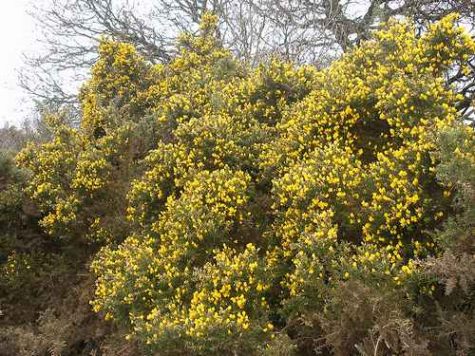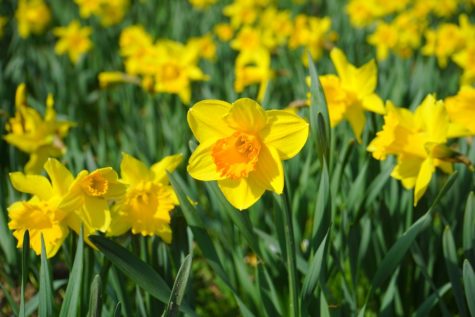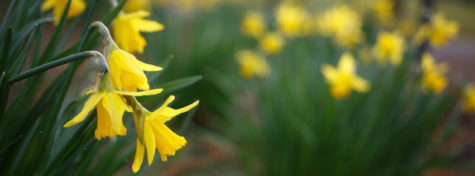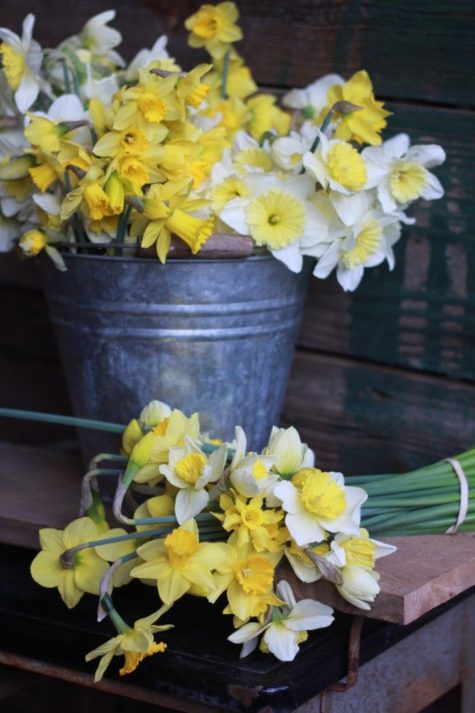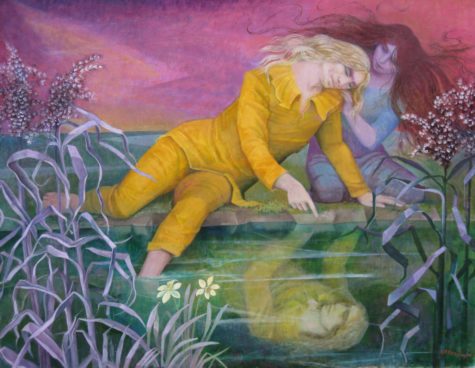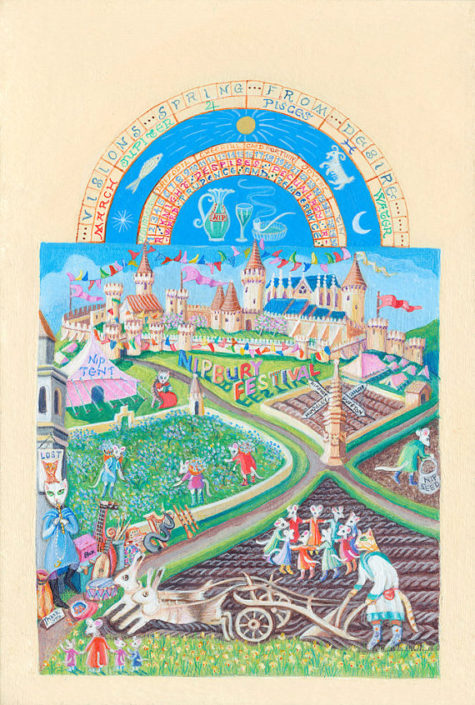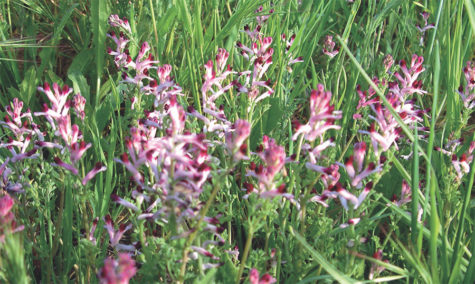shirleytwofeathers
When the Moon is at the full,
mushrooms you can safely pull,
but when the Moon is on the wane,
wait ere you think to pluck again.
Along with oysters, mushrooms have always been considered aphrodisiacs. The aphrodisiacal effect was increased if the mushrooms were picked at the time of the full moon.
Primitive people treated mushrooms with great respect, as it was so difficult to determine whether they were safe to eat. Even experts on mushrooms need to remember the old saying, “There are old mushroom hunters and bold mushroom hunters, but there are no old, bold mushroom hunters.”
Many mushrooms have “magical” properties, the toxins within them seeming to provide a gateway to another world. Images of fairies, elves, and goblins inevitably have a mushroom or toadstool nearby. In Chinese Mythology, mushrooms were one of the sacred foods eaten by the Immortals; they induced bodily lightness. Further, the fly agaric mushroom was said to grow only during times of peace and prudent leadership.
- Ruler: Neptune
- Type: Vegetable
- Magickal Form: Raw, cooked
This is the “flower” of illusion and many mushrooms are actually hallucinogenic. All mushrooms hold the property of fantasy and are eaten to invoke glamour or to create illusions.
- For love they should be cooked in soups with paprika and/or fish.
- To create glamours, or illusions, eat them raw.
The hallucinogenic effect of fungi has always been known, and used by shamans and warriors preparing for battle. Native Americans used hallucinogenic mushrooms in rites to produce visions, or embark on vision quests.
Rock paintings dating back at least 2000 years ago in the Tassili Plateau in southern Algeria depict shamans, apparently dancing around, holding mushrooms in their hands, with mushrooms sprouting from their bodies.
The Hebrews considered mushrooms as sacred and only priests were allowed to eat them.
Mushrooms were considered a delicacy in Roman times, but there was always the problem of determining whether or not they were edible. Emperor Claudius had this problem solved, as he used a food taster to eat some of his food first. Unfortunately, the mushrooms his taster tried one night produced no immediate effects. Consequently, Emperor Claudius ate them, and both he and his taster died. It is widely believed that his second wife, Aggripinna, who wanted her son Nero to have the throne, deliberately poisoned her husband.
Collected from various sources
- Black – Absorb and dispel negative influences, Mystery, Rememberance, Eternity, Constancy
- Blue – Healing, Peace, Astral projection, Fidelity, Sleep, Unity
- Brown – Animals, Helps connect to the rythms and energies of the Earth
- Gold – Activity, Money, The God, The Sun
- Green – Abundance, Calm, Fertility, Prosperity, Neutralize difficult situations, Renewal, Freshness, Hope
- Indigo – Clairvoyance, Healing, Past lives
- Orange – Attraction, Energy, Friendship, Willpower, Endurance, Strength
- Pink – Romantic love, Peace
- Purple – Communication with higher level beings, Connection with the Divine, Ending quarrels, Healing, Tranquility, Patience, Trust, Deep Sleep, Healing serious illnesses
- Red – Courage, Lust, New life, Desire, Passion, Sexuality, Strength, Enthusiasm
- Red Violet – Hidden knowledge
- Silver – Psychic abilities, Spirituality, The Goddess, The Moon
- Turquoise – Spiritual Knowledge
- White – Good fortune, Healing, Purification, Virgin Goddess
- Yellow – Creativity, Communication, Intellect, Knowledge, Youth, Mind Power, Light, Purity, Happiness, Wisdom
See Also: The Magickal Meanings of Colors
- Nature Spirits: Plant faeries
- Herbs: Basil, chives, dragons blood, geranium, thistle
- Colors: Crimson red, gold
- Flowers: Daisy, sweetpea
- Scents: Pine, bay, bergamot, patchouli
- Stones: Ruby, garnet, sard
- Trees: Pine, bay, hazel
- Animals: Bear, wolf
- Birds: Hawk, magpie
- Deities: Kali, Hathor, Anahita, Ceres, Ishtar, Venus, Bast
- Birth stone: Diamond
- Birth flower: Daisy or sweet pea
- Zodiac Signs: Aries (until April 19) and Taurus (April 20 onwards).
Power Flow:
Energy into creating and producing; return balance to the nerves; change; self confidence; self reliance; take advantage of opportunities; work on temper and emotional flare-ups and selfishness.
From: Moon Magic
Art by Jane Haworth
Trees have from time immemorial been closely associated with magic. These stout members of the vegetable kingdom may stand for as long as a thousand years, and tower far above our mortal heads. As such they are symbols and keepers of unlimited power, longevity, and timelessness.
An untouched forest, studded with trees of all ages, sizes and types, is more than a mysterious, magical place – it is one of the energy reservoirs of nature. Within its boundaries stand ancient and new sentinels, guardians of the universal force which has manifested on the Earth in vegetable form.
As such, a forest is an excellent spot for magical workings of any kind, not only tree magic. But any tree, anywhere in the world, can be used for the spells and techniques discussed here. Since each type of tree has its own particular powers, these are outlined below.
All trees, save for the poisonous ones (such as yew and hemlock) are excellent for healing magic. Any tree can be used to take away a headache and give you energy, or to reveal the future. We are limited purely by our own minds and actions.
It is important to talk to any tree(s) you are working magic with. Tell them exactly what your need is. Explain to them why the need exists and its urgency. Trees are living entities with a consciousness which, while different from our own, is still capable of communication upon subtler planes of awareness.
So, even though old spells sometimes direct you to pound nails or bore holes into trees – please don’t. This is not only damaging and hurtful to the tree, it is absolutely unnecessary, for there are other techniques available. These include binding or attaching to, burying at the base, and writing on leaves or twigs.
Some spells require marking symbols on leaves. A stick which has been burned on one end is excellent, for the charcoal will act as the graphite in a pencil. Practice with this until you become proficient.
The trees with which you cultivate magical relationships are things to be treasured; visit them often, even if you have no magic to perform. When you can arrive at the point when you accept the trees as friends, you have achieved a powerful bond between yourself, the Earth, and even beyond.
This is a short, very basic list of common trees and their associated powers. Please bear in mind that tree magic needn’t be limited to these tree types, for every tree has its own inherent powers which vary from tree to tree. Experiment!
- Almond: Divination. Clairvoyance. Wisdom. Money. Loans. Business.
- Apple: Healing. Prosperity. Love. Perpetual Youth.
- Ash: Protection. Sea Magick.
- Apricot: Love.
- Aspen: Protection.
- Birch: Protection. Purification. Fertility. New beginnings.
- Cedar: Prosperity. Longevity.
- Coconut: Purity. Chastity. Healing.
- Cypress: Past life workings. Protection.
- Elder: Healing. Protection. Prosperity.
- Elm: Protection.
- Eucalyptus: Healing.
- Fig: Fertility. Strength. Energy. Health.
- Hawthorn.: Cleansing. Marriage. Love. Protection.
- Hazel: Divination. Marriage. Protection. Reconciliation.
- Hemlock: Astral Projection, Not recommended for healing spells.
- Juniper: Protection.
- Lemon: Divination. Healing. Chastity. Neutrality.
- Lime: Divination. Healing. Chastity. Neutrality.
- Linden: Protection.
- Maple: Divination. Love.
- Mulberry: Knowledge. Divination. Wisdom. The will.
- Oak: Healing. Strength. Money. Longevity.
- Olive: Peace. Fruitfulness. Security. Money. Marriage. Fidelity.
- Orange: Love. Marriage.
- Palm: Strength.
- Peach: Love. Divination.
- Pine: Purification. Health. Fortune. Fertility. Prosperity.
- Rowan: Protection. Strength.
- Walnut: Healing. Protection.
- Willow: Healing. Protection. Enchantments. Wishing. Easy delivery of babies.
- Yew: Dark Magick. Not recommended for healing spells.
From: Earth Power
Furze (also known as Gorse) is a druid Sacred tree, whose flowers are associated with the Vernal Equinox (Aprox. March 20).
- Latin name: ulex europaeus
- Celtic name: ‘O’ – Onn
- Folk or Common names: Broom, Frey, Furze, Fyrs, Gorst, Goss, Prickly Broom, Ruffet, and Whin.
- Parts Used: Flowers
Magical History and Associations:
Furze is a thorny shrub with bright yellow flowers that is associated with the Spring Equinox. This herb is a symbol of the young sun at the spring equinox and royalty. Furze is associated with the astrological sign of Aries, the planet of Mars, the element of Fire, and is a masculine herb. Furze is associated with Jupiter, Thor, Onn, and also with the Gallic ash-grove Goddess On-niona. The color for Furze is dun, and its bird is the cormorant.
Magickal usage:
Furze is a symbol of fertility and has the magickal uses of Protection and Money. Furze is also used in money spells; it attracts gold. Furze is a good herb to use as a proctectant against evil. In Wales hedges of the prickly Gorse are used to protect the home against dark fairies, who cannot penetrate the hedge. Furze wood and blooms can be burned for protection and also for preparation for conflict of any sort. There are two school of thought about giving Furze flowers as a gift. On one had the gift is supposed to be good luck, but on the other hand if you give them to someone that you love it means: Anger.
There is an old rhyme about Furze that refers to its all-year-round flowering habits:
“When Gorse is out of bloom,
Kissing is out of season.”
Source: dutchie.org
As spring arrives, our gardens begin to bud and eventually bloom. For hundreds of years, the plants that we grow have been used in magic. Flowers in particular are often connected with a variety of magical uses. Now that spring is here, keep an eye out for some of these flowers around you, and consider the different magical applications they might have.
Crocus: This flower is one of the first you’ll see in the spring, and it’s often associated with newly blooming love. The crocus is also known to enhance visions and bring about intuitive dreams.
Daffodil: The bright petals of the daffodil are typically found in shades of white, yellow or even pale orange. This flower is associated with love and fertility — place fresh ones in your home to bring about abundance. Wear this flower close to your heart to draw love and luck.
Cowslip: The fragrance has healing properties.
Dandelion: The leaf of the dandelion is used for healing, purification, and ritual cleansing. To bring positive change about, plant dandelions in the northwest corner of your property. The bright yellow flowers can be used in divination, or placed in a sachet to draw good energy your way.
Echinacea: Also called purple coneflower, this garden mainstay adds a little bit of magical “oomph” to charms and sachets. Use it for prosperity related workings. Burn the dried flowers in incense, and use on your altar during ritual as an offering to deities.
Goldenseal: This sunny yellow flower is often found growing in the wild, alongside roads and in fields. Use it in money spells, or for business dealings. Work it into charms connected to matters of financial gain or legal issues.
Hibiscus: This lusty flower incites passion — use it to attract love or lust, or for prophetic dreams about your lover. Burn in incense, or carry in a sachet to bring love your way. Red Hibiscus flowers are used in love potions and placed in wreaths in marriage ceremonies.
Hyacinth: This flower was named for Hyakinthos, a Greek divine hero who was beloved by Apollo, so it’s sometimes considered the patron herb of homosexual men. Hyacinth is also known to promote peaceful sleep, and guards against nightmares. Carry in an amulet to help heal a broken heart or to ease grief when a loved one dies.
Lily: The Easter lily or Tiger lily is associated with all kinds of Spring connections — fertility, rebirth, renewal and abundance.
Marigold or Calendula: Add calendula to your bath to win the respect and admiration of your peers. String garlands of calendula around the outside doors to stop evil from entering the house.
Morning Glory: Morning Glory seeds under your pillow will stop nightmares. Grown in the garden, blue morning glories will bring peace and happiness.
Narcissus: Named for another Greek figure, the Narcissus helps promote polarity and harmony. Its calming vibrations bring about tranquility and inner peace.
Passion Flower: Placed in a house, it calms problems and troubles and brings peace. Carried, it attracts friends and popularity. Placed beneath the pillow, it aids in sleep.
Rose: Used in love and harmony spells. Roses planted in your garden will attract fairies. Rose petals sprinkled around the house will calm stress and reduce household upheavals.
Snapdragon: Place a vase of fresh snapdragons on the altar while performing protective rituals. If someone has sent you negativity energy (hexes, curses, etc.), place some snapdragons on the altar with a mirror behind them to send the negative energy back to the sender.
St. John’s Wort: wards off fevers and cold when worn; burn to banish evil spirits; gather it on a Friday and wear it to cure melancholy — (also known as Hypericum).
Sunflower: Sunflowers growing the garden guard it against pests and grant the best of luck to the gardener.
Tulip: The tulip appears in many different colors and varieties, but is typically connected to prosperity. You can use the different colored variations in color magic — use a dark strain such as Queen of the Night for full moon rituals, or bright red flowers for love magic.
Violet: In Roman myth, the first violet sprung from the spilled blood of the god Attis, who killed himself for Cybele, the mother goddess. However, today the violet is associated with tranquility and peace. The leaf offers protection from evil, and can be sewn into a pillow or sachet for a new baby. Carry the petals with you to bring about luck and enhance nighttime magic.
Source unknown
- Ruler: Venus
- Element: Water
- Parts Used: The flowers, either fresh or dried.
- Powers: Love, fertility, luck
Symbolizing rebirth, resurrection, renewal and new beginnings, the daffodil is virtually synonymous with spring. Though their botanic name is narcissus, daffodils are sometimes called jonquils, and in England, because of their long association with Lent, they’re known as the “Lent Lily.”
The Daffodil is a calming flower that helps bring about inner peace, hope and, of course, self-love. It may also be used in spells related to unrequited love. To dream about seeing or picking daffodils is said to symbolize happiness and adoration.
The name daffodil is a derivitave of affodell, which is a variant of asphodel. The Latin name for the daffodil is narcissus. Narcissus are also referred to as jonquils in North America.
- The daffodil is the emblem of Wales and is worn on St David’s Day.
- For spring flowers the daffodil is one of the best bulbs to plant.
- As the daffodil is one of the first flowers of spring, it has the flower meaning of hope.
Daffodil commonly refers to narcissus with large trumpets, but may be used for all types of narcissus. This is the official common name for ANY of the plants that fall into the genus Narcissus. So, if the plant is considered a Narcissus, it is also considered a daffodil as well. However, most people use the term “daffodil” when referring to the large, trumpet-shaped flowers of the Narcissus pseudonarcissus.
For the magick and lore of the Narcissus, visit this post: Narcissus Magick and Lore
In Victorian flower language daffodils signified regard and chivalry, whilst narcissi meant self esteem, female ambition or vanity.The daffodil is the March birth flower and the meaning it holds is friendship and domestic happiness.
The March birth flower daffodil that is commonly known, is yellow with a sweet fragrance. It is native to the Mediterranean, but has been cultivated all over the world as a decorative plant. The daffodil is a perennial grown from a bulb. It can reach heights of two feet. The daffodil is a dependable spring flower and a favorite for its long life and colorful blooms. It is poisonous if eaten.
Lore connecting the daffodil to not only a sign of winter’s end but a lucky emblem of future prosperity is found throughout the world. In Wales, it’s said if you spot the first daffodil of the season, your next 12 months will be filled with wealth, and Chinese legend has it that if a daffodil bulb is forced to bloom during the New Year, it will bring good luck to your home.
The March birth flower and the 10th wedding anniversary flower, a gift of daffodils is said to ensure happiness. But always remember to present daffodils in a bunch – the same legends that associate this cheerful flower with good fortune warn us that when given as a single bloom, a daffodil can foretell misfortune.
Daffodils are suitable altar decorations for any rituals celebrating the coming of spring and suitable offerings for solar deities, water and nature spirits, especially those identified as female. It should be noted that daffodils are toxic, especially the bulbs and can cause irritation to the skin and so should be used with appropriate caution.
Through folkloric mention, narcissus is a flower of the dead and of the underworld, making it suitable for funerary rites as well as those related to the changing of the seasons through rebirth allegory.
- Sprinkle dried petals or place fresh flowers on an altar to attract friendly spirits.
- Keep in the house or garden to cheer you up.
- Wear a daffodil in your breast pocket for luck and to have a cheerful mood follow you all day.
- Add to bathwater to increase your luck and bring new people into your life.
- A bouquet of daffodils in the bedroom may increase fertility.
- Mix with rose petals and place around a photo of a lover you want to return to you.
- Keep freshly cut daffodils in a vase in your home to bring about abundance.
- Place daffodils on your altar during workings related to love, especially if it’s a new relationship and you’re still trying to figure out how to navigate the waters.
- Add potted daffodil bulbs, don’t worry if they’re blooming yet, to your altar for spring celebrations, along with other spring flowers such as forsythia, crocus, and snowdrops.
- Wear this flower close to your heart to draw love, but be careful that your love is not one-sided.
They are good flowers for Geminis who like the cheerfulness of the yellow color and Pisces who appreciate the delicate scent of the white narcissi.
Daffodils in Mythology
Daffodils are also known as the narcissus, after the legendary young Greek man of the same name. Narcissus was pretty full of himself because he had been given the gift of great beauty by the gods. One day, a sweet young wood nymph named Echo spotted Narcissus hanging out by a stream and instantly fell in love with him. However, he was so busy being completely self-absorbed that he ignored Echo, and she wasted away from loneliness until nothing was left of her but her voice. Thanks to this tragic story of unrequited love, daffodils are sometimes used to represent a love that is one-sided.
Later, the goddess Nemesis, although in some versions, it’s Venus, got wind of what had happened to Echo, so she decided it was time to teach Narcissus a lesson. She led him to a stream, where he happened to notice the most beautiful young man he had ever seen – it was his own reflection, and he was so vain that he fell in love with his own image, transfixed, and forgetting to eat and sleep. Some of the other gods were worried that Narcissus was going to starve to death, so they turned him into a flower, which now blooms every year in the spring.
Daffodils in Love
Despite the issues of Narcissus and Echo, daffodils still appear in some folklore as representative of holding a lover in high regard. They send the message that this person is the only one for you, and your feelings are constant.
In some Middle Eastern magic, daffodils are considered an aphrodisiac.
Spiritual Daffodils
One prominent legend of the daffodil features in Christianity. It is said that on the night of the Last Supper, the daffodil appeared in the Garden of Gethsemane to comfort Jesus, who was saddened to know of his betrayal by Judas Iscariot.
The occurrence of wild daffodils is sometimes said to indicate the former site of a religious foundation. At Frittlestoke, near Torrington, Devon, it was recorded in 1797 that the people of the village call daffodils by the name Gregories, a name that coincided with the order of a neighboring monastery – the Canons of St Gregory.
In both Hampshire and the Isle of Wight, it was generally said that wild daffodils indicated the site of a monastery. St Urian’s Copse is well known for its primroses and daffodils. There is a tradition that daffodils grow in profusion on one side of a track running through the copse because a religious building once stood there.
From:
- Encyclopedia of Magickal Ingredients
- Patti Wigington
- Encyclopedia of Superstitions
- Teleflora
- Nature Spirits: Mer-people, Air and Water beings who are connected with spring rains and storms.
- Herbs: High John root, yellow dock, wood betony, Irish moss
- Colors: Pale green, red-violet
- Scents: Honeysuckle, apple blossom
- Stones: Aquamarine, bloodstone
- Trees: Alder, dogwood
- Animals: Cougar, hedgehog, boar
- Birds: Sea crow, sea eagle
- Deities: Black Isis, the Morrigan, Hecate, Cybele, Astarte, Athene, Minerva, Artemis, Luna
Power Flow:
Energy breaks into the open; growing, prospering, exploring. New beginnings; balance of Light and Dark. Breaking illusions. Seeing the truth in your life however much it may hurt.
From: Moon Magic
Art by Jane Haworth
Many assume that the term “Holy Water” indicates church-based water only. This is an oversimplification of a complex concept. The Roman Catholic Church did not invent the concept of Holy Water but adopted it from earlier Pagan use. Various Pagan shrines possessed virtually identical Holy Water fonts. Holy Water is a crucial component of many magical, religious and spiritual traditions, although what constitutes Holy Water and how it’s made varies greatly.
Water collected from the Jordan River, and water blessed by the church is considered Holy.
According to British folk tradition, rain falling on Holy Thursday – Ascension Day – may be gathered and used as Holy Water. Any other day held sacred to the spell caster may be substituted: Summer Solstice, May Eve, New Year’s, Samhain, your birthday, a saint’s day, etc.
Holy Water may also be made via astrological correspondences. Some believe that waters synchronized with a lunar eclipse or a Full Moon are holy and charged with extra magickal power.
Balinese tradition uses a variety of Holy Waters. These may include the water found within unripe coconuts or young bamboo. Ocean water is sometimes used as well.
Modern Wicca has evolved the notion of Holy Water. Various formulas exist. At it’s simplest, Witch’s Holy water is spring water with salt added. Different covens may have personal recipes, including infused herbs (rosemary, thyme, and vervain are particularly popular), or crystals.
Pow-Wow also features various recipes but the mainstay is water with salt and vervain added. Christian Pow-Wow may choose church-blessed waters instead.
Balinese Holy Water, Church-blessed Holy Water and Wiccan Holy Water (among others) are consecrated via sacred ritual: the ritual activates the water. Other magical traditions consider that the sacred, magical power of Holy Water is such that no further ritual or consecration is needed and may in fact be interference. Obtaining Holy Water may thus be as simple a gathering rainwater or adding sea salt to spring water. Complex rituals may also be designed.
Holy Water is most commonly used for:
- Cleansing and purification, both for individual bathing and for space-cleansing (sprinkle in corners).
- Altar cleansing and blessing.
- Healing spells.
- Holy Water is also believed capable of magically transmitting physical relief especially for headaches and tension. Use in compresses and massage.
- Cleansing and empowering materials and tools by either anointing them, or soaking them in the Holy Water.
- Exorcism and banishing spells.
A variety of recipes and rituals for making Holy Water can be found here:
- Book of Shadows – Full Moon Holy Water
- Magickal Apothecary – Holy Water
The name is said to be derived either from the fact that its whitish, blue-green color gives it the appearance of smoke rising from the ground, or, according to Pliny, because the juice of the plant brings on such a flow of tears that the sight becomes dim as with smoke, and hence its reputed use in afflictions of the eye.
According to the ancient exorcists, when the plant is burned, its smoke has the power of expelling evil spirits, it having been used for this purpose in the famous geometrical gardens of St. Gall.
Earth Smoke is also known as Fumitory. There is a legend that the plant was produced, not from seed, but from vapors arising out of the earth.
While this herb is most often used in money drawing incense formulas, it is also carried (in it’s dry form) in the shoes by salesmen for luck in making quick sales. It can also be brewed in water and the liquid sprinkled around the business premises to bring in quick money.
